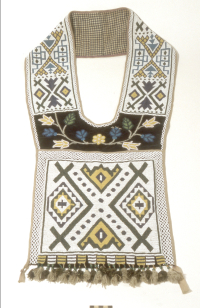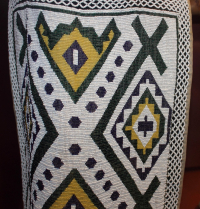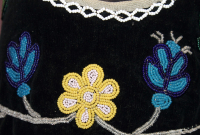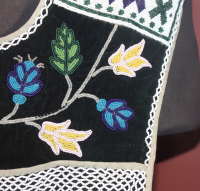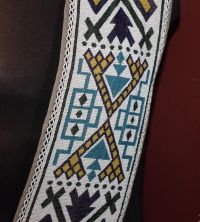Bandolier Bag
Bandolier Bag
Bandolier Bag
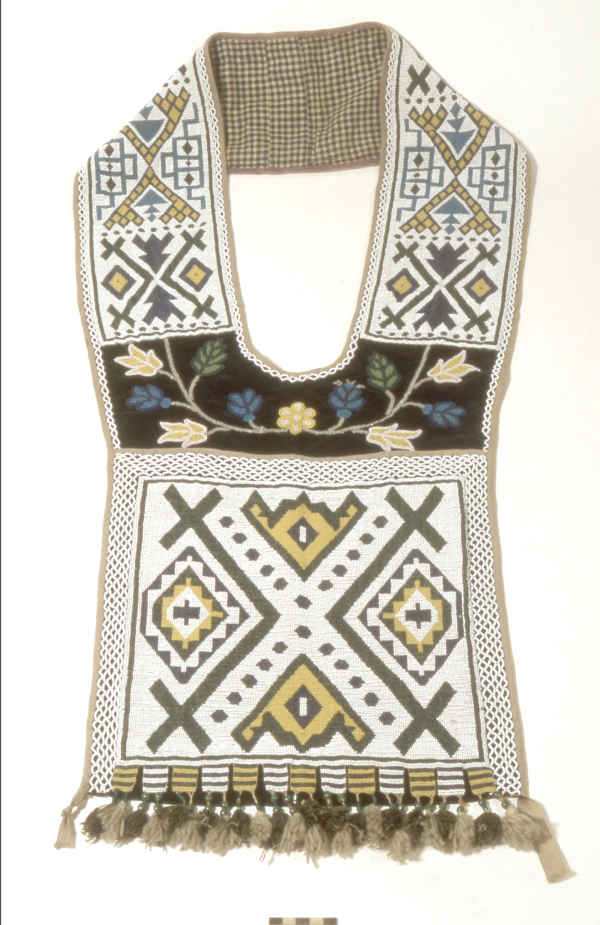
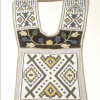
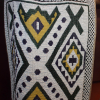
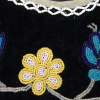
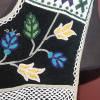
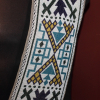
Loom-woven strap & pocket bead panels with printed cotton lining, overlay stitched floral beadwork on black velveteen, fringed with 12 beaded tabs
Also attributed to the Saulteaux cultural type
Summary of catalogue description
Read More About This Relative
Cotton broadcloth, seed beads, bias tape
Hand sewn, Lined with blue and white checked fabric, Loom-woven beadwork, Overlaid spot stitch appliqué on panel above pouch, Fringed with twelve loom woven beadwork tabs and wool tassels;
Loom woven seed beadwork on a cotton backing, lined with blue and white checked fabric, Pouch decorated by a loom woven, vertically symmetrical, beadwork panel in a geometric “X” design, in a white field Pouch is bordered on sides and top by four rows of interlocking diamonds, Fringed with twelve loom woven beadwork tabs each of geometric design and each with paired strands of semi-translucent yellow faceted tube beads, green translucent tube beads, opaque green pony beads and alternating green and white yarn wool tassels, Decorative panel above pouch adorn with symmetrical overlaid spot stitch appliqué, blue, yellow and green seed beadwork, in floral design, Decorative panel and outer perimeter of straps bordered by one line of interlocking diamonds, Design of loom-woven beadwork on straps vertically symmetrical in a repeating geometric “X” motif;
Bandolier bags most likely originated in the Upper Great Lakes region during the 1840s and 1850s. Fashioned exclusively from European materials and adorned with thousands of beads, bandolier bags were primarily for show, as a symbol of identity, wealth and status. Although initially functional, by the late 19th and early 20th centuries many of the bags had false pockets or none at all. Sometimes called "friendship bags", they were often created as gifts to strengthen relationships within communities or between nations. By the 1870s they had become an important element of formal dress worn mainly at ceremonies and celebrations by men, and occasionally by women. They wore them - singly or several at a time - crossed over the torso or draped around the neck. “The wearing of more than one bag was generally the prerogative of a leader or a person of high honour." (McCord, 2013) “Bandoliers were adopted by Ojibwa in 19th century after seeing bullet pouches used by British soldiers. Bullet pouches were plain and decorated with crest or coat of arms. When idea adopted by Ojibwa, they were greatly prized and highly decorated ceremonial accessories. They became so highly prized by Ojibwa and other tribes (especially Sioux), that one bandolier could be traded for one pony. They became a status symbol of highest ranking Midewiwin priests.(Flanders, 1977)
Provenance
Tag found inside pocket states "Rainy River Indian Chief's"
McCord Museum, Wearing Our Identity. Montreal: The McCord Museum, 2013; and “Beads: Their Use By Upper Great Lakes Indians” by Richard Flanders, 1977
Currently on long term exhibit in MM - Parklands/Mixed Woods Gallery (PMW-26)
from catalogue records
McCord Museum. Wearing Our Identity. Montreal: The McCord Museum, 2013. Print.
About This GRASAC Record
Manitoba Museum
Content from the Manitoba Museum's catalog records. Uploaded by Orvis Starkweather as part of their summer internship.













Attributed to the Northeast Great Lakes-Riverine Geo-Cultural area
 Knowledge Sharing Platform
Knowledge Sharing Platform

